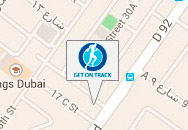Call Us Today!
04 380 55 69

Center Address :
Al Wasl Road, Umm Suqeim 3
Dubai, United Arab Emirates
Telephone : 04 380 55 69
Email : [email protected] 

COMMON NECK PROBLEMS
'Crick' Or 'Kink'
‘Crick’ or ‘Kink’ Is a term often used to describe the pain you wake up with after sleeping with your neck in an awkward position. It may also be due to working at the computer for long hours, or sudden movements of the neck. “Crick in the neck” is not a medical diagnosis. Usually a muscle spasm, trigger points, arthritis or a disc problem is the real culprit. Physiotherapist can take care of a crick in the neck most of the time, but if the pain lasts longer than a week or disrupts your usual activities, you should be referred to physician.
Neck Injuries
Certain neck injuries may also do damage to the nervous system by irritating nerve roots or affecting the spinal cord. Others may pinch or stretch a nerve. Generally, neck injuries that affect the nervous system are more complicated to diagnose, treat and cope with than soft tissue trauma or mild to moderate joint injury. Experienced Physiotherapists can perform several test to differentiate origin of pain and help you out how to about.
Whiplash Injury
Whiplash injury is a set of symptoms following an injury in which the head is thrown first backward then quickly forward. It’s most often due to car accidents, but may be caused by sports injuries, falls or trauma. It’s an event that may result in neck strain or sprain. Whiplash may also damage joints or discs.
Herniated Disc
Occurs when the soft substance on the inside of the disc pushed out. Should this substance land on a nerve root, which it often does, you’ll likely feel pain and have symptoms such as weakness, numbness and/or pins and needles down your arm. Damage of this structure may happen by either repeated or a sudden, forceful stress to the joint. For example, lifting a heavy load with a twisted spine may cause a disc to herniate. Treatment generally starts with medication and physiotherapy, but may proceed to surgery as needed.
"Stingers And Burners" (Named For The Way They Feel)
Stingers and burners are temporary injuries to the nerve root or occur most often in contact sport athletes. They may be caused by either by an abrupt tilt of the head or when the head and shoulder are forced in opposite directions at the same time. Symptoms include burning, stinging, numbness/weakness, or an electrical sensation down one arm. If a stinger or burner is severe or lasts longer than a few minutes, you must see a Physician.
Neck Fracture
A neck fracture is a break in a neck bone. It may be caused by trauma, a fall or degenerative changes in the spine. Contact sports population and elderly people with osteoporosis are particularly at risk for neck fractures because their bones are very fragile. The most serious neck fractures are generally accompanied by a disclocation. Treatment depends on a lot of things including your age, other medical conditions and extent of damage to your spine. If a fracture destabilizes your neck, you may need to wear a brace.
Cervical Dislocation
Dislocation occurs when a neck bone moves out its normal position, creating spinal instability. An injury or degenerative changes can disrupt the ligaments that hold the vertebra in place, causing it to separate from the bone below. Dislocations may damage the spinal cord and/or require surgery. Less severe forms occur when the bone does not move all the way out, or when only one side fully displaces. Mild dislocations may go back in place on their own.
Spinal Cord Injury
spinal cord injury occurs when a fracture, dislocation or other neck injury damages the spinal cord. If the spinal cord is damaged at the 3rd cervical vertebra or above, the person may die or need a respirator.
Rheumatoid Arthritis
Can destroy joints in the neck and cause severe stiffness and pain. Rheumatoid arthritis typically occurs in the upper neck area.
Cervical Disk Degeneration (Spondylosis)
The disk acts as a shock absorber between the bones in the neck. In cervical disk degeneration, the normal gelatin-like center of the disk degenerates and the space between the vertebrae narrows. The cervical disk may also protrude and put pressure on the spinal cord or nerve roots when the rim of the disk weakens. This is known as a herniated cervical disk.
Possible Pain on the neck
- General pain located in the neck area, as well as stiffness in the neck muscles.
- The pain may radiate down to the shoulder or between the shoulder blades.
- It may also radiate out into the arm, the hand or up into the head, causing a one-sided or double-sided headache.
- Acute pain can give rise to abnormal neck posture in which the head is forced to turn to one side. This condition is known as torticollis.
- The pain at the base of the skull may be accompanied by a feeling of weakness in the shoulders and arms.
- There may be a prickly or tingling sensation in the arms and fingers.
In all the listed conditions, besides proper diagnose by a physician, the physiotherapy approach is important. Your Physiotherapist will assess you and plan the appropriate individual program of rehabilitation. All presented conditions are characterized with individual symptoms, therefore a custom plan and program is essential for recovery.